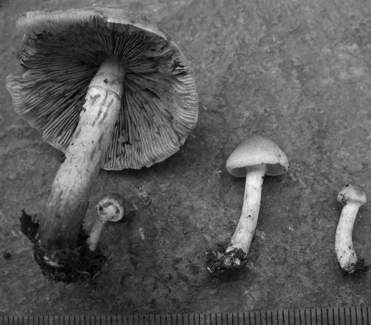 Hebeloma ifeleletorum (Photo: B. Kropp)
Hebeloma ifeleletorum (Photo: B. Kropp)Taxonomy
Full name: Hebeloma ifeleletorum Kropp, Mycologia 107 (1): 153 (2015)Genus: Hebeloma
Section: Porphyrospora
Types: AMERICAN SAMOA: Tutuila Island, National Park of American Samoa, Tutuila Unit, along Mount Alava Trail (approx. 14.286°S, 170.7139°W, alt. approx. 190 m a.s.l.) on soil in subtropical woodland under Intsia bijuga, 19 May 2009, B. Kropp (Holotype. herbarium acc. no. UTC 00235643, HJB1000386).
- arrow_drop_downarrow_drop_upEtymology
- arrow_drop_downarrow_drop_upDiagnosisHebeloma ifeleletorum differs from H. lactariolens by its smooth pileus and by lacking a swollen stipe base, from Hebeloma indica by having larger basidiospores and rostrate pleurocystidia and from H. angustilamellata by having much smaller basidiomata. It is phylogenetically and ecologically divergent from Hebeloma youngii. Etymology: belonging to Ifelele, the Samoan name for the tree Intsia bijuga. Pileus 3–32 mm diam, at first broadly conic with the margin slightly inrolled, later expanding and becoming convex, smooth, lacking an umbo; reddish brown to buff (5YR 4/6–7.5YR 8/4) at the pileus center, becoming pale buff to cream (10YR 8/3) toward the margin; a pale whitish veil is present before expansion. Lamellae 0.5–1.5 mm wide (dry material), narrowly attached, close, with even concolorous edge; pallid or pale pinkish brown when young, dull pinkish brown (5YR 7/4) at maturity, lamellulae 1–2 mm long. Stipe 9–39 x 2–7 mm, central, terete, equal or slightly enlarged toward the base, hollow, pliant; surface finely pruinose over the upper third of the stipe, otherwise lightly longitudinally fibrillose with faint annular cortinate remains present, some fibrils and the remains of the cortina become brownish mostly from spore deposits; stipe light buff to cream (10YR 8/3–8/2), the base becoming reddish brown (5YR 4/4) at maturity. Dried spore print on white paper dull reddish brown (5YR 5/3). Odor faintly fungoid to acidulous. Context pallid, no color changes observed. Basidiospores 9.0(10.6) 11.0 3 5.5 (6.8)7.5 μm, Q = 1.55, ornamented (O4) with a loosening perispore (P2) but cavernae not obvious under light microscopy, amygdaliform, not cyanophilous, not reacting in Melzer’s reagent (D0). Basidia 20–27 x 8–9 μm, fourspored, clavate. Cheilocystidia 25–55 x 7–14 μm, numerous, hyaline, thin-walled, variable but mostly clavate to cylindrical or fusiform. Pleurocystidia 25–35 x 8–11 μm, not abundant, hyaline, thin-walled, mostly rostrate occasionally with an elongated tip. Pileipellis a layer of enlarged cylindrical to subglobose cells, 12–25 μm wide, with a thin superficial, slightly gelatinized layer; golden brown encrusting material present. Lamellar trama of parallel, smooth hyphae 4–8 μm wide. Stipe surface at apex a loosely woven covering of hyphae with numerous irregular mostly clavate cystidioid tips, 28–50 x 5–12 μm; at base covered with loosely woven hyphae, 3–6 μm wide, with some golden brown encrusting material. Clamp connections present.
References
Description
- arrow_drop_downarrow_drop_upThresholds
Description of Hebeloma ifeleletorum based on 1 collections
- arrow_drop_downarrow_drop_upMacroscopic descriptionPileus: (3) 17 (32) mm diameter; shape convex, umbonate or weakly umbonate; characters remains of universal veil; margin characters Not recorded; viscosity tacky when moist; colour variation two color; colour at centre Not recorded.
Lamellae: attachment adnexed; maximum depth not recorded; number of complete lamellae up to 76; presence of tears Not recorded; white fimbriate edge present.
Cortina presence: yes.
Stipe: (9) 24 (39) x (2) 4 (7) {median} x (3) 5 (8) {basal} mm; stipe Q 4.5–5.6; base shape clavate or cylindrical; floccosity fibrillose or pruinose at apex; rooting Not recorded; thick rhizoids at base Not recorded;
Context: Texture firm; stipe interior hollow; stipe flesh discolouring yes; slenderness measure up to 10.1; smell earthy; taste Not recorded.
Spore deposit colour: Not recorded.
Exsiccata characters: Not recorded.
- arrow_drop_downarrow_drop_upMicroscopic descriptionSpores: shape amygdaloid or limoniform; colour in microscope Not recorded; guttules no. papilla yes; Spore Code: O4; P3; D3.
Basidia: 27–34 x 7–8 μm; ave. Q up to 3.8; spore arrangement 4 spored;
Cheilocystidia: main shape ventricose; special features observed often rostrate; cheilocystidia ratios: A/M = up to 0.42; A/B = up to 0.33; B/M = up to 1.28.
Pleurocystidia: seen.
Ixocutis: epicutis thickness (measured from exsiccata) not recorded; ixocutis hyphae width not recorded; ixocutis hyphae encrustation Not recorded; shape of trama elements beneath subcutis Not recorded.
Caulocystidia: Similar to cheilocystidia but larger, up to 60 μm.
- arrow_drop_downarrow_drop_upSpore measurements
- arrow_drop_downarrow_drop_upCheilocystidia measurements
- arrow_drop_downarrow_drop_upHabitat and distributionHebeloma ifeleletorum's preferred habitat appears to be subtropical woodland. Across our collections, Hebeloma ifeleletorum has only been recorded as associating with Intsia (family Fabaceae). The growth habit of our collections was caespitose.
According to our current collections, the species is found only in Pacific. From collector information, it appears collections have been found in the IUCN habitats We map from the collector's description of the habitat to the International Union for Conservation of Nature (IUCN)'s definition using a standardised set of rules. Please see this page for a full list of IUCN habitats.. Within Pacific all our records are from Southwestern Pacific (American Samoa).
Geographic distribution
Phenology
- arrow_drop_downarrow_drop_upAdditional cited collections